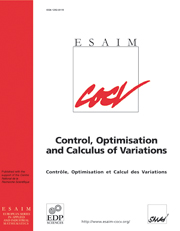Article contents
Second-order sufficient conditions for strong solutions to optimal control problems∗
Published online by Cambridge University Press: 14 March 2014
Abstract
In this article, given a reference feasible trajectory of an optimal control problem, we say that the quadratic growth property for bounded strong solutions holds if the cost function of the problem has a quadratic growth over the set of feasible trajectories with a bounded control and with a state variable sufficiently close to the reference state variable. Our sufficient second-order optimality conditions in Pontryagin form ensure this property and ensure a fortiori that the reference trajectory is a bounded strong solution. Our proof relies on a decomposition principle, which is a particular second-order expansion of the Lagrangian of the problem.
Keywords
- Type
- Research Article
- Information
- ESAIM: Control, Optimisation and Calculus of Variations , Volume 20 , Issue 3 , July 2014 , pp. 704 - 724
- Copyright
- © EDP Sciences, SMAI, 2014
References
- 3
- Cited by




